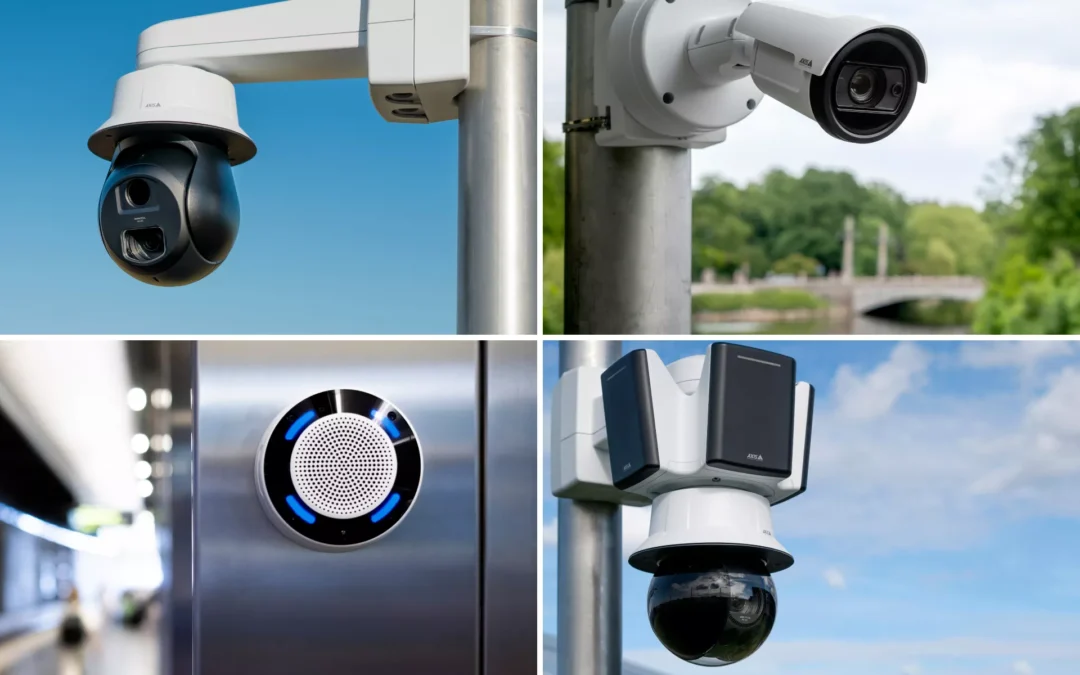Walk into most food processing plants today and you’ll see more than conveyors and stainless steel. You’ll spot cameras in sanitary enclosures, smart radars watching outdoor perimeters, sensors scanning air, and digital locks that only open when the right person, with the right clearance or color uniform, walks up. Food processing security has evolved. And the latest product launches we saw at GSX 2025 show exactly where the industry is headed next.
At Data Link, we help our clients stay ahead of the curve to find the best enterprise physical security solution. Here are some of the major security trends transforming U.S. food processing security.
1. Washdown-Ready & Multisensory Cameras: Beyond Just “Weatherproof”
Food plants demand rugged hardware to survive daily cleaning and aggressive sanitation. But the frontier is merging environmental sensing with surveillance. At GSX 2025, Axis unveiled a bispectral PTZ camera (the AXIS Q6411-LE) that marries thermal + visual imaging in one unit.
This is powerful for food processing because a single device can now detect heat signatures (e.g. overheated equipment, thermal anomalies in zones) while also capturing crisp visual detail for classification and verification. In essence: washdown durability plus multi-sensing.
2. Edge AI + Smarter Bullets: Analytics Built In
Many of the newer products incorporate edge analytics, including the AXIS AI-powered bullet cameras. They’re designed with ARTPEC-9 chips, built-in DLPU, and pre-installed analytics for classifying humans, vehicles, and more.
For a food plant, that means a bullet camera overlooking a raw material staging area could spot unauthorized personnel, vehicles dumping pallets, or trespassers — all in real time, without sending video to the cloud first.
The boundary between “security camera” and “smart sensor” continues to blur. Expect more bullet cams doing heavy lifting at the edge.
3. Hybrid Detection with Radar + Video Fusion
In large sites, such as outdoor yards, loading docks, and perimeters, pure video can struggle with clarity (we’re talking night, fog, or stray shadows). This is where radar steps in. Axis’s new radars pair with cameras for “radar-video fusion.”
Imagine a bulk ingredient delivery area. A radar could detect a moving vehicle at night, then activate a camera to verify it’s a scheduled delivery truck, not a forklift dropping off late with no prep clearance.
Layered sensing is trending — radars + video combining into one smart system means fewer false alarms and better detection fidelity.
4. Air Quality & Environmental Sensors — The New Safety Frontier
Surveillance is expanding beyond sight and into air. At GSX, Axis introduced the AXIS Air Quality Sensor, detecting pollutants, vaping, smoke, plus two-way audio and visual alerts.
In food processing, air quality is already critical (humidity, airborne particulates, cross-contamination aerosols). Having a dedicated sensor that talks to your VMS and facility controls is a next wave, not only for safety but for process and compliance.
Cameras won’t always be enough; environmental sensing is becoming part of the security + safety stack.
5. Access Control + Video + Systems Convergence (Now with Smarter Inputs)
All these new sensors and smart devices augment the convergence story. Think about it: your access control logs, visual records, thermal alerts, radar triggers, and air quality events all feed into one system. That’s not the future, it’s now. Axis called it “multisensory intelligence” for complex environments. With new sensors in the mix, the integration becomes richer and more actionable.
6. Cybersecurity Built In (Yes, from the Inside)
One of the standout features is the inclusion of Axis Edge Vault, a hardware-based cybersecurity module, in the new cameras and radars. It uses FIPS 140-3 Level 3 secure key storage, protecting cryptographic keys at the hardware level.
That’s not just a nice bonus, it’s essential. As more devices go “smart,” the risk surface expands. Food processors must insist that their sensors and cameras have security baked in, not bolted on.
Security systems need security themselves. A smart camera that gets hacked is a bigger liability than a dumb camera.
7. Real-Time Enforcement — Because in Food, Latency Is the Enemy
The fastest contamination, cross-zone incursion, or PPE lapse happens in seconds. Edge AI, fusion sensing, onboard analytics, all reduce dependency on remote processing and accelerate response times. The new multisensory theme from Axis is built to operate with minimal latency.
In a modern line, that could mean a gloveless hand, a heat spike, or an unauthorized person triggers multiple sensors simultaneously, alerting operations before anyone notices.
8. Compliance & Auditability — A Core Driver
With all these new capabilities, plants can produce audit trails richer than ever. A contamination event can be correlated with badge logs, video, thermal data, air quality readings, and radar triggers — all timestamped. That’s a compliance story built right in, not retrofitted.
The Future of Food Processing Security
Security in food processing is no longer a passive guardrail — it’s a proactive, sensitive, and intelligent system. The latest devices underscore where things are headed:
- Cameras that sense both heat and light (bispectral PTZ)
- Smart bullets with built-in analytics
- Radar + video fusion for fewer false alarms
- Air quality sensors that plug into security systems
- Hardware-level cybersecurity (Edge Vault)
- Real-time, low-latency enforcement
At Data Link, we’re excited to help food processing companies integrate these new tools in ways that make sense for operations and your bottom line.
Ready to future-proof your plant? You could say cutting edge, customized enterprise security solutions are our “secret sauce.” Let’s set up an assessment of your systems.

